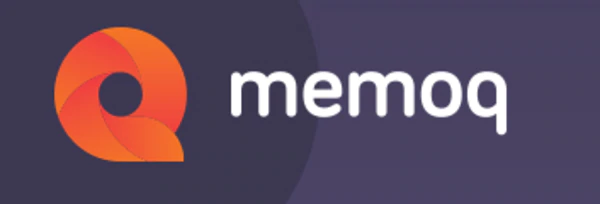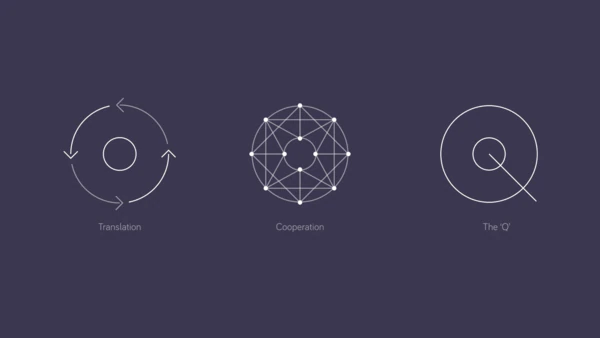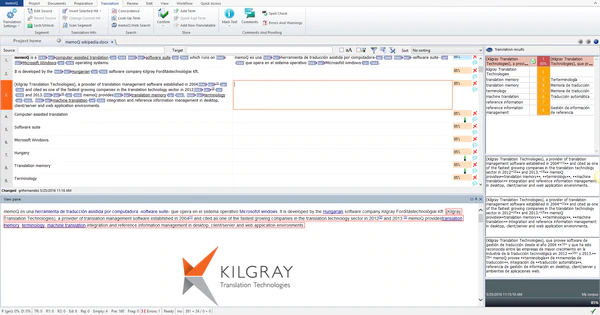Note: This blog entry was originally written in Japanese in 2019 for our Japanese website. We used our machine translation platform Translation Designer to translate the entry into English and to post-edit the output for readers outside of Japan. The original Japanese entry can be found here.
In the translation industry, it is common to use CAT tools when translating. CAT stands for Computer Assisted Translation, which literally means computer-aided translation. With the advent of CAT tools, which is software used by translators around the world, translation work has been dramatically speeded up and the productivity has also improved dramatically.
In this article, we will introduce memoQ, which is currently gaining a large-scale share among many CAT tools. Why has memoQ become a tool comparable to CAT mogul SDL Trados? This article will approach the mystery.
What is memoQ?

(From memoQ official website).
memoQ is a CAT tool developed by Hungarian-based Kilgray Translation Technologies (now memoQ Translation Technologies). The first version was released in 2006 and has undergone numerous updates since then, with version 8.7 being the latest version in the final release of 2018.
CAT tools can be broadly divided into two types: cloud-based and local-based. And memoQ has become a pioneer of tools that adopt cloud-based.
The strength of memoQ seen from its logo
What are the unique strengths of memoQ? If you look at the meaning of memoQ's logo, it will be a little easier to know.

(From memoQ official website)
It's consisted of Translation, Cooperation, and the Q. The Translation symbol appears to be a series of streams connected in a circle. One of the strengths of memoQ is that the translation process runs automatically and seamlessly on memoQ. The Translation symbol symbolically represents this strength.
In the Cooperation symbol, the points of the circle are connected. Another strength of memoQ is that each linguist and the person in charge of the project can collaborate in real time by utilizing the cloud. Also, the terms and translation memories, or TMs, provided by each linguist can be shared interactively.
Q is an alphabet that is reminiscent of "Question." memoQ has a lot of QA functions to guarantee the quality of translations. The QA function can also be said to be one of the strengths of memoQ. There are many other functions in memoQ, but first, let's focus on these three to take a closer look at memoQ functions.
Translation: Seamless translation management with cloud-based efficiency
The biggest feature of memoQ is the online project that utilizes the cloud. A project is created on the cloud, and multiple translators can access the project at the same time and proceed with the translation. Using cloud-based memoQ, which enables online projects, there is a large-scale advantage for linguists and parties handling files, in order words, the project management side (mainly translation companies).
In a normal project, the project management side hands the file to the translator, and receives the file back when the translation is completed. Then the project management side hands the file to the reviewer when reviewing is necessary, and receives the file back when the review is completed. Communication via the project management side will definitely occur.
However, in the case of memoQ's online project, that interaction is completely unnecessary. If you register the linguists online in advance, the reviewer will be automatically contacted when the translation work is completed, and the reviewer will be able to start the work. You can eliminate the troublesome file preparation and handling, achieving a seamless project management.
In addition, the work status is shared online in real time, so the project manager can check the progress of the file assigned to a translator in real time without asking about it every time. Also, the fact that multiple linguists can access the work files uploaded on the cloud and proceed with the translation work at the same time will shorten the translation delivery time.
Cooperation: Real-time information sharing, improving the translation quality as well
Furthermore, by adopting an online project, the TM and glossary set in the project are updated in real time, and the latest entry can be immediately shared with all linguists. Even if a customer specifies a term, it can be shared immediately. Also, linguists register new translations in the TM in real time, so it is possible to reduce the inconsistency of an expression.
In addition, memoQ has a convenient communication function that allows linguists to easily communicate with each other and with the project management side. During the translation process, linguists often ask questions about the content and style. In the past, we often exchanged emails and managed questions on other platforms. However, with memoQ, you can receive queries on the tool, answer them, and even share the content with other linguists. Translation work, translation management, and query management can all be integrated into one platform, which leads to more efficient work for both the linguist side and the project management side.
These benefits of adopting an online project are only possible because memoQ is cloud-based, and will not be available with Trados, which employs a local base.
The Q: QA tool
memoQ has a powerful QA tool. It automatically points out errors in usage of numbers and terms, formatting, and other items. It is especially useful for large-scale projects because it automatically detects inconsistent translations in segment units and can easily match them.
Not only can you use the QA tool provided by default, but also you can customize the checklist according to your project and automatically detect errors using those items. This makes it possible to minimize the risk of oversight by the human eye and having the errors left.
Other benefits: Reasonable price
In addition, memoQ has strengths that cannot be obtained with other CAT tools.
Trados has been a pioneering CAT tool, with a long history, and is still the most popular CAT tool in the translation industry. From translation companies to translation departments at corporations and individual translators, it is highly popular, but it is also pricey, making the initial investment expensive.
On the other hand, although memoQ is still a new tool, it has been able to offer a cheaper price compared to Trados. Furthermore, if the project management side (translation company) purchases a memoQ license, the linguist side can simply download the application for free and start translating using a license granted by the project manager.
Other benefits: Look and feel
In addition, memoQ has a good reputation for the easy-to-understand editor screen. The editor screen is the screen you see the most when translating. On the editor screen of memoQ, the original text and the translated text are arranged in a bilingual format side-by-side, and you can choose the windows to display that support your translation work, such as TM and term base. If you have experience using general CAT tools, it will be very familiar to you.

(From memoQ official website)
Summary
By comparing memoQ and SDL Trados, you can probably see that the benefits of adopting cloud-based tools are the strength of memoQ. However, the advantages of cloud-based applications sometimes become their disadvantages, such as being affected by network conditions and making the operations slow.
But memoQ has many characteristics not found in conventional CAT tools, and is especially useful for large-scale projects that require multiple linguists. You should definitely include it as one of the options depending on the conditions of the project and the preferences of your client.
Kawamura's Translation Designer
It is very useful to introduce CAT tools such as memoQ to manage translation projects in-house, but many people probably hesitate because of the initial investment. Some may think that they want to use machine translation, glossary, or TM functions to translate in-house, but would not need up to a project management function.
Translation Designer provided by Kawamura International is a translation platform that supports machine translation while having a TM function and glossary reference function. If you think an expensive CAT tool is too much but want to improve the efficiency of the translation work, Translation Designer is a fit for you. Please check out the details here.
_CMYK_OL.png)

